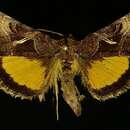Conservation Status
provided by University of Alberta Museums
A common widespread species; no concerns.
- license
- cc-by-nc
- copyright
- University of Alberta Museums
Cyclicity
provided by University of Alberta Museums
Adults have been collected in Alberta from late June through early August.
- license
- cc-by-nc
- copyright
- University of Alberta Museums
Distribution
provided by University of Alberta Museums
Primarily a western mountain species (northern Alaska south to southern California and New Mexico, with an apparently disjunct population in Labrador), but also found sparingly across the boreal forest and the subarctic. In Alberta, it has been collected throughout the mountains and foothills, east to the Calgary and Lethbridge (?) areas. It should be watched for in the Alberta Cypress Hills and in the Boreal Forest region.
- license
- cc-by-nc
- copyright
- University of Alberta Museums
General Description
provided by University of Alberta Museums
A medium-size moth (2.9-3.2 cm wingspan) with reddish-brown forewings and bright yellow-orange hindwings. The forewings are brown with the lower two-thirds of the area between the antemedian and postmedian lines darker, almost black. Stigma is a silver dash and narrowly forked at the upper end. Hindwings are bright yellow-orange, with a black terminal band. Very similar to S. alticola, which has darker, blackish-brown forewings, a shorter stigma and a more zigzag terminal line. Other Syngrapha species with yellow hindwings (borea, orophila, microgamma) have mainly grey forewings and different stigmas. Autographa sansoni is larger and has pale yellow hindwings. There are also genitalic differences (see References). The antennae are simple and the sexes are similar. Older literature refers to ignea as S. hochenwarthi, a closely related Palearctcic species."
- license
- cc-by-nc
- copyright
- University of Alberta Museums
Habitat
provided by University of Alberta Museums
Subalpine and lower elevation meadows, roadsides, clearings, edges and other non-wooded habitats.
- license
- cc-by-nc
- copyright
- University of Alberta Museums
Life Cycle
provided by University of Alberta Museums
Adults of the Mountain Beauty are active both during the day and at night, and are attracted to lights. There is a single brood each season.
- license
- cc-by-nc
- copyright
- University of Alberta Museums
Trophic Strategy
provided by University of Alberta Museums
No Alberta data. The only available host plant information is from lab rearing at the CNC. Larvae in the lab were reared on blueberry (Vaccinium) but switched to willow (Salix) in the late instars.
- license
- cc-by-nc
- copyright
- University of Alberta Museums
Syngrapha ignea
provided by wikipedia EN
- license
- cc-by-sa-3.0
- copyright
- Wikipedia authors and editors
Syngrapha ignea: Brief Summary
provided by wikipedia EN
Syngrapha ignea, the mountain beauty, is a moth of the family Noctuidae. The species was first described by Augustus Radcliffe Grote in 1864. It is found from northern Alaska south to southern California and New Mexico, with a disjunct population in Labrador. It is also found sparingly across the boreal forest and the subarctic.
The wingspan is 29–32 mm. Adults are on wing from June to August depending on the location. There is one generation per year.
The larvae feed on Vaccinium and Salix species.
- license
- cc-by-sa-3.0
- copyright
- Wikipedia authors and editors

